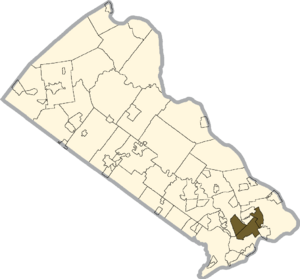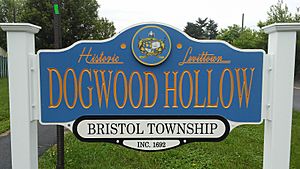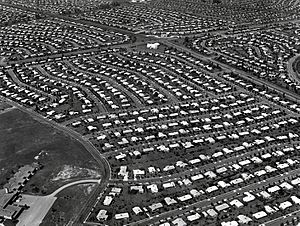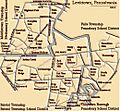Levittown, Pennsylvania facts for kids
Quick facts for kids
Levittown
|
|
|---|---|

|
|

Location of Levittown in Bucks County
|
|
| country | United States |
| state | Pennsylvania |
| County | Bucks |
| Area | |
| • Total | 10.40 sq mi (26.94 km2) |
| • Land | 10.30 sq mi (26.68 km2) |
| • Water | 0.10 sq mi (0.26 km2) |
| Elevation | 30 ft (9 m) |
| Population
(2020)
|
|
| • Total | 52,699 |
| • Density | 5,116.41/sq mi (1,975.38/km2) |
| Time zone | UTC−5 (EST) |
| • Summer (DST) | UTC−4 (EDT) |
| ZIP Codes |
19054–19055 and 19057–19058
|
| Area codes | 215, 267, and 445 |
| FIPS code | 42-42928 |
|
Pennsylvania Historical Marker
|
|
| Designated: | August 8, 2017 |
Levittown is a special kind of community called a census-designated place (CDP) in Bucks County, Pennsylvania, United States. It is a planned community, meaning it was designed and built from scratch. Levittown is part of the Philadelphia metropolitan area. In 2020, about 52,699 people lived there.
Levittown is about 40 feet (12 meters) above sea level. It is not an official city or town. However, it is often seen as the largest suburb of Philadelphia. Levittown was planned and built by a company called Levitt & Sons. This happened after they bought land in 1951. The brothers William Levitt and Alfred Levitt designed the six main types of houses. Levittown is about 72.5 miles (116.7 km) southeast of Allentown. It is also about 26.6 miles (42.8 km) northeast of Philadelphia.
Contents
History of Levittown
Most of the land for Levittown was bought in 1951. Levitt & Sons built only six types of houses. These were all single-family homes with yards. The house models were called the Levittowner, the Rancher, the Jubilee, the Pennsylvanian, the Colonial, and the Country Clubber. They had small differences on the outside. The homes were not too expensive and needed only a small down payment.
Building Levittown started in February 1952. This was soon after another Levittown was finished in Levittown, New York. Levittown, Pennsylvania, was the second "Levittown" built by William Levitt. He is often called the creator of the modern American suburb.
To build homes quickly, Levitt & Sons used a special 26-step method. It was like an assembly line for houses. The house stayed in one place. Workers moved from one house to the next. Each worker did the same task over and over. This included pouring foundations, putting up walls, or installing pipes. When they were building the most homes, workers could finish a house every sixteen minutes. They started building in 1952 and finished in 1958. In total, 17,311 homes were built.
What made Levittown special was that it was built as a complete community. Levitt & Sons designed neighborhoods with curved roads. These roads helped slow down traffic. There were no four-way intersections. Each neighborhood had land set aside for a public elementary school. This land was given by Levitt & Sons. Places for churches and other public buildings were also set aside. These were on main roads like Levittown Parkway.
The community also had many fun things to do. There were large public swimming pools and parks. There were also green areas, baseball fields, and playgrounds. A big, modern shopping center was built nearby in Tullytown. It was the largest shopping center east of the Mississippi River at the time. The first four sample homes were shown near the future Levittown Shop-a-Rama. About 30,000 people came to see them on the first weekend.
People who lived in Levittown, called Levittowners, had to follow many rules. These rules were about keeping their homes and yards tidy. For example, they could not hang laundry outside on Sundays. They also could not put fences around their yards. But over time, these rules became hard to enforce. Especially when backyard pools became popular. People wanted fences for privacy. After Levitt & Sons stopped building, new types of homes were added. These included "garden apartments" and other houses not built by Levitt.
William Levitt's company had a policy of only selling homes to white families. The Federal Housing Administration (FHA) also had rules. These rules often limited home sales to people of "the Caucasian race". This was written in housing agreements. However, a Jewish couple, Bea and Lew Wechsler, helped an African-American family buy a home. In 1957, William and Daisy Myers became the first Black family to buy a home in the Dogwood Hollow section. Their move to Levittown was met with unfair treatment and large crowds. State authorities had to step in. This led to legal action against those causing problems. The Myers family and their supporters did not give up. They became known across the country for their bravery. Daisy Myers was even called "The Rosa Parks of the North." She helped show the problems with racial inequality in northern states. Daisy Myers later wrote a book about her family's experiences. She passed away on December 5, 2011. Groups like the NAACP and the ACLU spoke out against Levitt's policies. The FHA even threatened to stop giving mortgages for his next Levittown. Levitt still refused to sell to Black families. He planned another white-only Levittown in Willingboro Township, N.J. He fought legal challenges in New Jersey courts. But the U.S. Supreme Court chose not to hear his case.
The community faced another challenge in June 1979. This was during the "suburban gas unrest." It happened after a second oil shortage from Arab countries. The unrest took place on June 24–25, 1979. Gas lines grew long, and people became angry. This happened at a place in Levittown called Five Points. It had six gas stations nearby. Two of them were damaged during the unrest. The two days of unrest made national news. President Jimmy Carter even mentioned it in a speech he planned to give.
A baseball team from Levittown won the Little League World Series in 1960. The Levittown American team beat a team from Fort Worth, Texas.
Of the five public pools built by Levitt & Sons, four were closed in 2002. Only one in the Pinewood section stayed open. The main office of the Levittown Public Recreation Association (LPRA) and other important places are being preserved. Since 2002, there have been studies to make Levittown a historic district.
The Bucks County St. Patrick's Day Parade has been held in Levittown since 1988. Every year, the parade starts at St Joseph the Worker Church. It then goes two miles (3 km) on New Falls Road. It ends at Conwell-Egan Catholic High School. St Joseph the Worker Church has since been taken down.
Neighborhoods of Levittown
Levittown is not a single official town. Instead, it is made up of 41 neighborhoods. These neighborhoods are spread across four different areas:
- Bristol Township
- Falls Township
- Middletown Township
- Borough of Tullytown
Some people in Levittown tried to make it an official town in the early 1950s. But some residents worried that this would mean higher taxes. This is because the new town would not have enough businesses to tax.
The Levittown Shop-a-Rama was a large shopping center built in 1955. It was in Tullytown, on the edge of Levittown. It was shaped like an "L" and had stores facing a big parking lot. There was also a courtyard with green spaces and benches. Big stores like Pomeroys (later Boscov's), Food Fair, and JC Penney were there.
The shopping center started to decline in the mid-1970s. This was because the Oxford Valley Mall was built nearby. The Oxford Valley Mall was much bigger and enclosed. It drew shoppers away from the older Levittown center. In 2002, the Shop-a-rama site was rebuilt. It reopened as the Levittown Town Center. It now has about 468,675 square feet (43,539 square meters) of stores.
The names of streets in each neighborhood usually start with the same letter as the neighborhood's name. For example, in the Pinewood section, streets might be named Pinewood Lane. This helps people know where a street is located. The letters "X" and "Z" are not used for section or street names. Neighborhoods are often circled by a "drive" with the same name. For example, Pinewood section is circled by Pinewood Drive.
Some neighborhoods have special names. Red Rose Gate, Forsythia Gate, and Snowball Gate are called "The Gates." These neighborhoods did not have sidewalks. This was to make them look more fancy. Lakeside is next to Levittown Lake. Thornridge is on a ridge that used to have thorn bushes. Vermilion Hill is named for the color the trees turn in the fall. Magnolia Hill is on a noticeable hill. Mill Creek Falls is next to a creek with the same name.
Education
Students in Levittown go to public schools. Which school district they attend depends on which part of Levittown they live in:
- Neshaminy School District serves residents in Middletown.
- Bristol Township School District serves residents in Bristol Township.
- Pennsbury School District serves residents in Falls Township and Tullytown.
Some students also go to private schools. These schools are run by Catholic, Lutheran, evangelical Protestant, and Quaker groups. These schools are in and around Levittown.
Geography
Levittown is located at 40°9′15″N 74°50′59″W / 40.15417°N 74.84972°W. It is in the southern part of Bucks County. It sits between Philadelphia and Trenton, New Jersey. Downtown Philadelphia is about 22 miles (35 km) away. Levittown is part of the Philadelphia metropolitan area. This area is also known as the Delaware Valley. It is next to and almost surrounds Fairless Hills. Fairless Hills is a smaller community but shares many features with Levittown.
Levittown has a total area of about 10.2 square miles (26.4 square kilometers). A small part of this, about 0.5 square kilometers (0.59%), is water. The climate here is generally warm and humid in summer. Winters are cold. Average monthly temperatures range from about 32°F (0°C) in January to 76°F (24°C) in July.
Transportation
SEPTA Regional Rail trains serve Levittown. The Levittown station is to the south on the Trenton Line. To the north, the Langhorne and Woodbourne stations are on the West Trenton Line.
Interstate 295 (I-295) runs north and west of Levittown. It connects the area to suburbs near Trenton. The Pennsylvania Turnpike (I-95) is southwest of Levittown. It links to Philadelphia and the New Jersey Turnpike. U.S. Route 1 (US 1) runs north. It takes traffic directly into downtown Trenton.
The closest international airport is Philadelphia International Airport (PHL). It is about 34 miles (55 km) southwest of Levittown. The nearest Amtrak train station is in Trenton. It is just across the Delaware River at the Trenton Transit Center. This is about 9 miles (14 km) to the east.
Many Levittown residents travel for work. They often commute by car or train to Philadelphia, Trenton, or Princeton. Some even travel to other states. About ten percent of working residents live and work within Levittown itself.
Population Facts
Levittown has seen its population change over the years:
- 1990: 55,362 people
- 2000: 53,966 people
- 2010: 52,983 people
- 2020: 52,699 people
In 2010, the population of Levittown was mostly White (87.7%). About 5.1% were of Hispanic or Latino background. About 3.6% were Black or African American. And 1.7% were Asian.
Most adults in Levittown have at least a high school diploma (85.4%). About 13.4% have a college degree or higher.
Famous People from Levittown
- Keith Armstrong, a football coach for the Tampa Bay Buccaneers
- Susan Barnett, a news anchor for CBS 3 Philadelphia
- Anna Burger, a leader in the SEIU
- Jim Cawley, a former Lieutenant Governor of Pennsylvania
- David A. Christian, a decorated U.S. Army veteran
- Rick DeJesus, a musician
- Steven E. de Souza, a Hollywood writer and director
- Bob Zupcic, a former baseball player for the Boston Red Sox
- Brian Fitzpatrick, a U.S. Representative
- Mike Fitzpatrick, a former U.S. Representative
- Eric Goldberg, a Disney animator and director
- Steven Kunes, a TV writer and producer
- Jeri Massi, an author
- Joe McEwing, a former Major League Baseball player
- Bill O'Neill, a professional bowler
- Robert Schooley, a creator of Kim Possible
- Mark Schweiker, a former Governor of Pennsylvania
- Steve Slaton, a former running back for the NFL's Miami Dolphins
- David Uosikkinen, a drummer for the band The Hooters
- Troy Vincent, a former NFL defensive back
- Earl "the Twirl" Williams, a former professional basketball player
Images for kids
See also
 In Spanish: Levittown (Pensilvania) para niños
In Spanish: Levittown (Pensilvania) para niños







